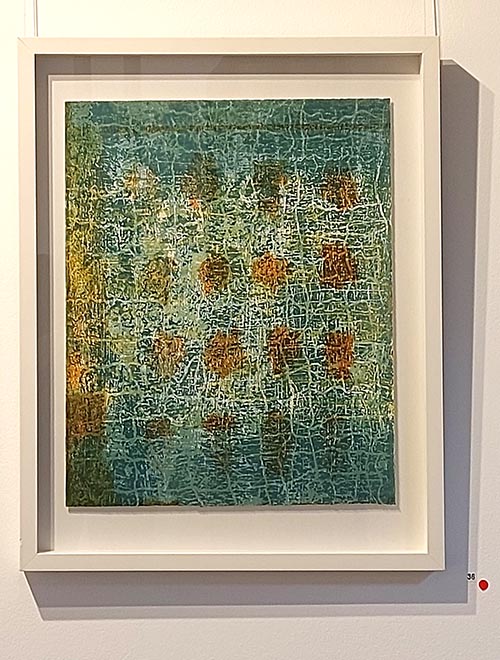
Today I visited this printmaking exhibition at the Incinerator Art Space in Willoughby. The works were created by three artists who share a studio: Rhonda Nelson, Anna Russell and Anthea Boesenberg, and most had a collagraph element included in their matrix usually combined with another printing technique.
The pieces shown in the header above (Anthea Boesenberg, Atmospheres) are described as Relief Collagraph Monotypes and Andrea explained her process to us. Instead of applying ink evenly across a collagraph plate, ensuring it reaches the lower crevices, then wiping away the excess from the higher points before pulling a print she uses a roller across the surface, thereby only inking up the highest areas and prints that. By using either (or both) multiple plates or multiple colours she can create complex imagery.
Anna Russell, Transmissions 1-3, etching & collagraph, 99 x 98cm
The pieces above (grouped and sold as a whole) were the highlight of the day for me. I’m attracted to the colour scheme, the tonal variation and the layers of imagery. They’re a very cohesive group and have a vibrancy and dynamism that forces me to keep examining them and taking in every individual section. When you get up very close you can appreciate the finer marks that aren’t evident in my photo.
Rhonda Nelson, Summer Light, etched linoprint, 50 x 40cm
Etching lino is quite interesting. It can be done a couple of different ways that I know of:
- A resist (a stop-out) can be painted onto selected areas of the lino so those areas aren’t eaten away by the caustic soda solution. The lino is then laid into a caustic soda + water bath and allowed to remain there while the solution reacts with the surface. Once the required effect has been achieved the lino is removed and rinsed. It’s then ready to be inked up and printed.
This method can be done progressively by putting the lino into the bath several times having stopped out more and more sections each time. This will produce differing depths of etching and create tonal variety.
- Another way to etch into the surface is to mix the solution and paint it directly onto the areas of lino you want to etch. This can be rather hit and miss as the solution will run and spread but if you’re after effects such as splattering and running in rivulets across a piece it can be quite effective, if time-consuming and a little random.
When doing this in a painterly manner you could first apply a resist as with the first method. It’s a fascinating thing to do.



